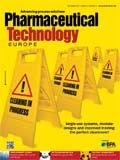Avoiding Contamination Risks in Aseptic Processes
Pharmaceutical Technology Europe
Contamination is almost always related to human error and there is a clear drive to reduce human implications in aseptic operations. This can be achieved in multiple ways.
Contamination is almost always related to human error and there is a clear drive to reduce human implications in aseptic operations. This can be achieved in multiple ways. Some solutions include:
- Isolation of the operator: the use of barriers such as isolators and restricted access barrier systems (RABS) are more and more frequently used to separate the filling area from the operator. This trend has been reinforced by the tendency of regulatory authorities to increase their scrutiny on aseptic filling facilities that use old designs, such as clean rooms.
- Use of disposables: disposables can reduce the cost of operations, including labour work in cleaning, cleaning validation and QA/QC. The cost of disposables is, of course, higher, but the total cost is reduced.
- Reduction of exposure: exposure is recognised as a contamination risk. Few people claim that the filling environment is guaranteed contamination free. Therefore, several technologies have been developed to help reduce exposure, such as by using specialised containers; for example, many people have reported projects being launched using Blow-Fill-Seal (BFS) containers in recent years. BFS is well known to strongly minimise exposure thanks to the very short cycle times before the container is fully closed.
When it comes to equipment, the main contamination risks are the contact parts, exposure risk and operator intervention, but specialised equipment, particularly barrier systems, can help to minimise all of these. Barrier systems have multiple advantages. Firstly, the operator, is kept away from the filling area by physical separation. The quality of such design has been recognised by authorities and led to significant changes in facility design. For example, isolators are usually located in ISO8 clean room instead of ISO7 clean room with all the savings attached to the simplification of the facility design and the ease of operations.

Benoît Verjans
Operations such as clean-in-place (CIP) and steam-in-place (SIP)—though designed to optimise the sterility assurance level of product contact parts—remain complex and, consequently, are a source of contamination because of potential errors. Compared with these operations, the use of connectors to cross barriers and disposable sterile product paths are simple solutions to set up product path in robust aseptic conditions. In addition, containers may help to minimise contact parts. For example, the insides of ampoules, BFS and Crystal vials are never in contact with equipment contrary to vials and prefilled syringes with their respective stoppers and plungers in contact with vibrating bowls and ramps.
Length of exposure to the environment is also an issue because the probability of contaminants entering the container is higher if the exposure time is longer. On that basis, containers that require very short operating time are preferable to ones requiring longer steps. Three container bodies help minimise exposure to the environment: prefilled syringes, which are supplied sterile in tubs and immediately processed through filling and plunger placement; BFS, which is immediately filled after moulding at high temperature; and the closed vial which is kept permanently closed and immediately processed to filling and laser re-sealing. On the contrary, open classical glass vials and ampoules wait a long time fully open from the hot air tunnel to the filling and closing stations. Unfortunately for prefilled syringes, plungers, as the vial stoppers, are still exposed for long periods of time in vibrating bowls.
Another risk is operator intervention because humans are always a source of contamination. Equipment manufacturers have the task of making systems more reliable and reducing the number of steps. One recent trend in the pharma industry is to reduce the speed of filling equipment in order to minimise short stops. The result is that the output is not so affected thanks to the elimination of many short stops and the quality is improved.
Barriers to new technology uptake
The largest barrier hindering the uptake of new aseptic technologies is the pharma industry’s reluctance to use a technology that has not been approved yet. There is always a small risk that a complete drug development application using new technology will be rejected by regulators. However, this risk is minimised if both the vendor and the pharmaceutical company together build a solid scientific rationale, including robust risk analysis, to support the use of new technology. Authorities are also open to informal presentations of new technologies and, in my experience, are much more open to new technologies than many believe. It would be useful if authorities provide official advice and opinions on new technologies regarding their potential acceptability and benefit to the patient. This could significantly accelerate the development of new technologies and provide faster benefits to patients.

Crop/Getty Images
The future
In the coming years, I believe that the authorities will reject more aseptic solutions which do not minimise contamination risk. Five years from now, equipment in a clean room setting may face difficulties to be approved for aseptic filling as a robust risk analysis would point out the risk of contamination due to the vicinity of the operator and the filling area . Instead, use of barrier systems and disposable technologies will continue to grow; several companies now offer fully disposable solutions for biological drugs that can be used throughout fermentation, purification, formulation and during the filling process.
Containers will also evolve; several companies have already begun to replace glass with more robust materials, such as polymers. As a result, there will be a decreased risk of small cracks, which are a significant source of contamination. Furthermore, big problems, such as the recently discovered issue of delamination with several drugs such as Erythropoietin and methotrexate, may be avoided.
Benoît Verjans is chief commercial officer of Aseptic Technologies. http://www.aseptictech.com

Drug Solutions Podcast: A Closer Look at mRNA in Oncology and Vaccines
April 30th 2024In this episode fo the Drug Solutions Podcast, etherna’s vice-president of Technology and Innovation, Stefaan De Koker, discusses the merits and challenges of using mRNA as the foundation for therapeutics in oncology as well as for vaccines.